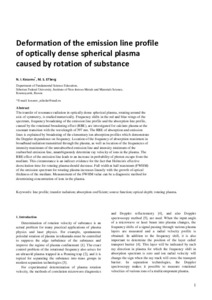Deformation of the emission line profile of optically dense spherical plasma caused by rotation of substance
Скачать файл:
URI (для ссылок/цитирований):
https://doi.org/10.1088/1402-4896/ab49f9https://elib.sfu-kras.ru/handle/2311/128471
Автор:
Косарев, Николай Иванович
Эльберг, Мария Сергеевна
Коллективный автор:
Институт цветных металлов и материаловедения
Кафедра фундаментального естественнонаучного образования
Дата:
2019-10Журнал:
Physica ScriptaКвартиль журнала в Scopus:
Q3Квартиль журнала в Web of Science:
Q3Библиографическое описание:
Косарев, Николай Иванович. Deformation of the emission line profile of optically dense spherical plasma caused by rotation of substance [Текст] / Николай Иванович Косарев, Мария Сергеевна Эльберг // Physica Scripta. — 2019. — Т. 94.Аннотация:
The transfer of resonance radiation in optically dense spherical plasma, rotating around the axis of symmetry, is studied numerically. Frequency shifts in the red and blue wings of the spectrum, frequency broadening of the emission line profile and the absorption line profile, caused by the rotational broadening effect (RBE), are investigated for calcium plasma at the resonant transition with the wavelength of 397 nm. The RBE of absorption and emission lines is explained by broadening of the elementary ion absorption profiles which demonstrate the Doppler dependence on frequency. Location of the frequency of absorption maximum in broadband radiation transmitted through the plasma, as well as location of the frequencies of intensity maximum of the unreabsorbed emission line and intensity minimum of the reabsorbed emission line, unambiguously determine ray velocity of ions in the plasma. The RBE effect of the emission line leads to an increase in probability of photon escape from the medium. This circumstance is an indirect evidence for the fact that Holstein's effective deexcitation time for rotating plasma should decrease. Full width at half maximum (FWHM) of the emission spectrum for rotating plasma increases linearly with the growth of optical thickness of the medium. Measurement of the FWHM value can be a diagnostic method for determining concentration of ions in the plasma.

